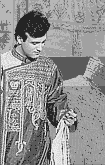No wonder Sharbari’s menswear thundered into the fashion
landscape. It was like an irresistible gust of wind that blows
away age-old notions of can and can’t and left everybody
breathless. Older men did a double take, trapped in their inhibitions.
But the younger ones, mindful of the mirror and the new glint
in the eyes of their woman, took to Sharbari with a zeal of
the new convert. To be followed by dad even granddad; who were
slower to shed conventions but have been no less steady in their
patronage of Sharbari’s.
We speak of zeal and converts through, of course, Sharbari’s
isn’t a religion, only a much talked-about designer label
and Sharbari in no high priestess but only the woman designer,
venturing into a distinctive line of menswear. However, she
has always had a philosophy of fashion.

“I pitied men their dull wardrobes. The west has enslaved
us to notions of masculine dress codes which we forget have
only a short history, dating after the Industrial Revolution.”
It has done something else, too. It had tutored Indian men to
turn away from their own rich dress heritage.
Indian’s, both men and women, were fond of dressing up,
"from Mohenjodaro to the Mughals“, she says and never
tries of pointing out that sartorial flair wasn’t confined
to aristocratic finery, Sherwani, Angrakha, Piran, Bandhgala,
Kurtas… The ingenious weaves and colours and cuts of folk
costumes offer breathtaking variety, too.
Sharbari wanted to change the language of men’s fashion
by mining both the urban and the village traditions, updating
them for wear. After all, it wouldn’t do to create quaint
“costumes”. Thereafter old and new were merged in
a stunning statement of style at once relevant, artistic and
sophisticated. And, eminently wearable on different occasions.
Not like the outrageous flights of fancy that turn heads fr
the ramp but are impossible to wear off it. Impossible for most,
that is.
Sharbari believes fashion trends move both in a linear direction
and in a circular manner, earlier codes resurrected as new long
after they died out. The elaborate styles of a bygone age of
leisure and pleasure are coming back. With a vengeance. As a
woman, Sharbari welcomes the changes of tastes. After all, women
have eyes, too. As a designer she should feel a sense of satisfaction,
for isn’t she more than a little responsible for this
new awareness about the new look of menswear? She’s been
able to do what she wanted.

Of course, imitations have been flooding the market. That
doesn’t ruffle the designer. After all. it is a kind of
tribute and merely proves her growing demand. Moreover, no copy
can dupe her clientele which is an impressive list of discerning
loyalists, not necessarily filthy wealthy but certainly artistic
in taste. How could it? For one thing, copies, however faithful,
invariably lack the delicate finesse. For another, they can
never be unique the way each Sharbari item is.
Her designs are unique not only because each piece is exclusive
: the designer draws directly on cloth, impromptu, without prelims,
preserving no copy for afterwards, so that repetition is impossible.
They are unique because Sharbari’s idiom is an inventive
fusion of different art traditions, and evolved into an elegant
expression distinctly her own. Cave and folk art; Egyptian mural;
calligraphy of West and East Asia; still life; Pop art and Picasso;
miniatures; Hindu Mythology are sources of inspiration, not
copied, but recalled and re-invented with insouciant artistry
so that their traditional identities are lost in new creations.
A piran has a startling icon
: Ravan. Another more mainstream : Krishna destroying Kalia. A
kurta sports a chaos of shards. Yet another shows an impressive
dragon. Or leaping deer. Or tribal warriors. Or a nonsense script.
Or simply geometric patterns. All ordered into intelligent permutations
and in a fine range of rhyming rather than contrasting colours.
Calcutta often surfaces in her work. She’s often tried out
playful tableaux depicting colonial Calcutta in dhoti borders;
a fetching montage of gaslights and carriages. Hookahs and reclining
babus, very popular with ‘pucca’ executives just discovering
the sensuous elegance of this traditional wear. Indeed, Calcutta
is Sharbari’s city. As the daughter of Ajit Datta, a leading
poet of the post-Rabindranath era, she imbibed its literary and
artistic traditions as naturally as one breathes.
The Sharbari range has done more than giving man a new look :
it has given them glamour.




